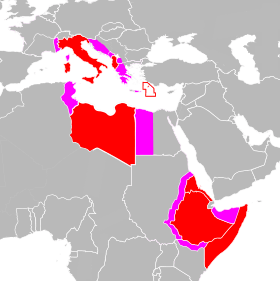Italian Tripolitania
| Italian Tripolitania | ||||||
| Tripolitania Italiana | ||||||
| ||||||
| ||||||
| Capital | Tripoli | |||||
| Languages | Italian Arabic | |||||
| Religion | Islam Roman Catholicism | |||||
| Government | Colony | |||||
| Historical era | Interwar period | |||||
| - | Established | 1927 | ||||
| - | Disestablished | 1934 | ||||
Italian Tripolitania was an Italian colony, located in present-day western Libya, that existed from 1927 to 1934. It was part of the Italian North African territory conquered from the Ottoman Empire in 1911. Italian Tripolitania included the western northern half of Libya, with Tripoli as its main city.
History

Italian Tripolitania, and Italian Cyrenaica, became independent colonial entities within Italian North Africa in 1927. In 1934, Italian Tripolitania and Cyrenaica became part of Italian Libya.
A large number of Italian colonists moved to Tripolitania in the late 1930s. These settlers went primarily to the area of Sahel al-Jefara, in Tripolitania, and in the capital Tripoli. In 1939 there were in all Tripolitania nearly 60,000 Italians, most living in Tripoli (whose population was nearly 40% Italian).[1] As a consequence, huge economic improvements arose in all coastal Tripolitania. For example, Italians created the Tripoli Grand Prix, an internationally renowned automobile race.[2]
In December 1934, individual freedom, inviolability of home and property, the right to join the military or civil administrations, and the right to freely pursue a career or employment were guaranteed to autochthonous Libyans (later called by Benito Mussolini "Moslem Italians").[3]

In 1937, northern Tripolitania was split into Tripoli Province and Misrata Province.
The Province of Tripoli (the most important in all Italian Libya) was subdivided into:
In 1943 the region was invaded and occupied by the Allies; this was the end of the Italian colonial presence.
Italy tried unsuccessfully to maintain the colony of Tripolitania after World War II, but in 1947 relinquished all Italian colonies in a peace treaty.
Infrastructure
In Italian Tripolitania were made many infrastructures by the Italians: the most important were the coastal road between Tripoli and Benghazi and the railways Tripoli-Zuara, Tripoli-Garian and Tripoli-Tagiura. Other important infrastructures were the enlargement of the port of Tripoli and the creation of the Tripoli airport.
A group of villages for Italians and Libyans were created on the coastal tripolitania during the 1930s.[4]
Notes
- ↑ Images of old Tripoli
- ↑ Video of Tripoli Grand Prix
- ↑ Sarti. The Ax within p 190
- ↑ Chapter Libya-Tripolitania (in Italian)
Bibliography
- Chapin Metz, Hellen. Libya: A Country Study. Washington: GPO for the Library of Congress, 1987.
- Del Boca, Angelo. Gli italiani in Libia. Vol. 1: Tripoli bel suol d'Amore. Milano, Mondadori, 1997.
- Sarti, Durand. The Ax within: Italian Fascism in Action. Modern Viewpoints. New York, 1974.
See also

- List of colonial governors of Tripolitania
- Postage stamps and postal history of Tripolitania
- Territorio Sahara Libico
- Italian Libya Railways
.svg.png)

